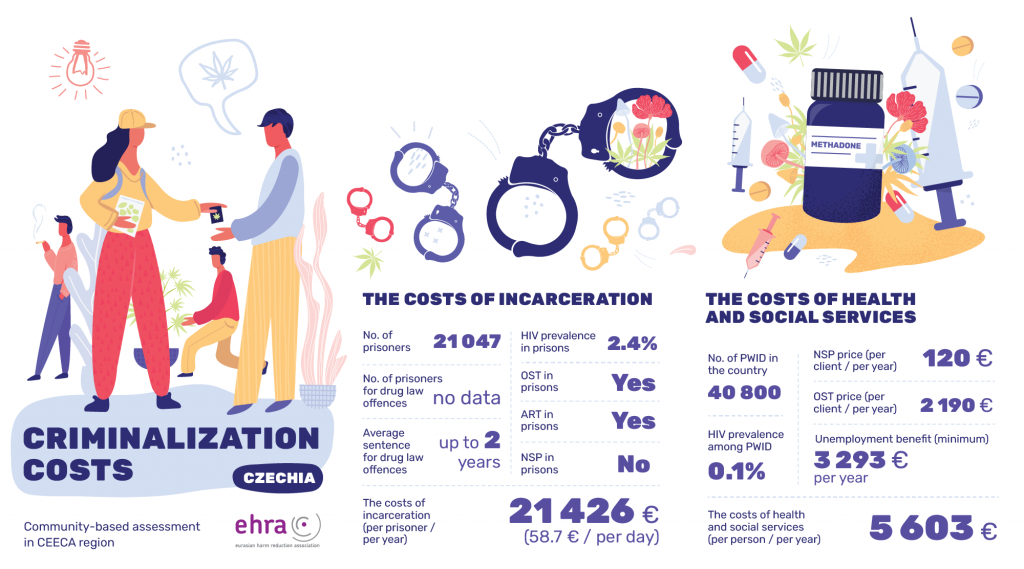As of 2019, there were 21,047 people in the prisons of Czechia, including those in pre-trial detention [1]. The average sentence for drug law offences can be for up to 2 years duration [2]. HIV prevalence among prisoners in 2015 was estimated at 2.4% [3] and antiretroviral therapy (ART) is available to prisoners [4]. Opioid substitution therapy (OST) is officially available in 10 prisons but, in reality, can only be accessed in 6 of them, with 86 prisoners in receipt of the service in 2019 [5]. No needle/syringe programmes (NSP) are being implemented in the prisons of Czechia [6].
Expenditure per prisoner in 2019 was €21,426 per year, or €58.70 per day [7].
The number of people who inject drugs was estimated at 40,800 in 2019 [8] with a HIV prevalence of 0.1% [9]. The cost of NSP is estimated at €120 (CZK 3,150) per client, per year and OST at approximately €2,190 per person, per year, depending upon the substance used [10]. The unemployment benefit is €3,293 per person, per year, calculated using the minimum wage [11].
Therefore, the cost of providing assistance to one person who injects drugs in community settings is €5,603 per year, or €15.35 per day, compared with €21,426 per year, or €58.70 per day, to detain the same person in prison. The Government of Czechia could save up to €15,823 per drug user, per year, or €43.35 per day, with an overall saving to the state of up to €36.6 million per year.
[1] Aebi M F, Tiago MM. SPACE I – 2020 – Council of Europe Annual Penal Statistics: Prison populations. Strasbourg; Council of Europe, 2021. https://wp.unil.ch/space/files/2021/04/210330_FinalReport_SPACE_I_2020.pdf (accessed 3 August 2021).
[2] Penalties for drug law offences in East Europe and Central Asia at a glance: https://old.harmreductioneurasia.org/drug-laws/
[3] United Nations Office on Drugs and Crime (UNODC). World Drug Report 2015. Vienna; UNODC, 2015. https://www.unodc.org/wdr2015/en/maps-and-graphs.html (accessed 6 August 2021).
[4] Harm Reduction International (HRI). Global State of Harm Reduction 2020, Regional Overview 2.2 Eurasia. London; HRI, 2021. https://www.hri.global/files/2020/10/26/Global_State_HRI_2020_2_2_Eurasia_FA_WEB.pdf (accessed 3 August 2021).
[5] Mravčík V, Chomynová P, Grohmannová K, Janíková B, Černíková T, et al. Annual Report on the state of the drugs problem in the Czech Republic in 2019. Prague; Council for Drug Policy Coordination, October 2020. In Czech. https://www.drogy-info.cz/data/obj_files/33369/1076/VZdrogy2019_v02_s%20obalkou.pdf (accessed 6 August 2021).
[6] HRI, Ibid.
[7] Aebi MF, et al, Ibid.
[8] Mravčík V, et al, Ibid.
[9] European Monitoring Centre for Drugs and Drug Addiction (EMCDDA). Czechia Country Drug Report 2019. Luxembourg; Publications Office of the European Union, 2019. https://www.emcdda.europa.eu/system/files/publications/11339/czechia-cdr-2019_0.pdf (accessed 6 August 2021).
[10] Information provided by national partners.
[11] Employment. Ministry of Labour and Social Affairs, 2021. https://www.mpsv.cz/web/en/employment (accessed 6 August 2021).

